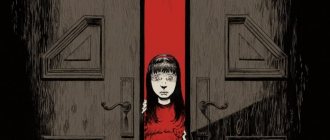Most children between the ages of three and 12 are afraid to be alone in the dark. It seems to them that the darkness hides something within itself. As soon as he is left alone, a terrible monster will crawl out from under the bed or a terrible “babaika” will jump out from a dark corner. After reaching the age of twelve, many experience this fear and forget about it. But not all. There remain a number of children who not only cannot stop being afraid, but also take their fear into later life.
Help your child overcome their fear of the dark!
There will no longer be scary monsters from under the bed, but various shadows, rustling sounds, black holes, and so on. And the more horror films and thrillers you allow your child to watch, the more scary it will be for him to be alone in the dark. After all, as you know, what we fear begins to come to life in our minds precisely at the moment when we are especially scared or in pain.
The sooner you detect this problem and take appropriate action, the faster you can deal with it. Fear of the dark requires mandatory parental intervention, because the child will not be able to cope on his own. Psychologists from different countries have developed special techniques and sets of exercises that can effectively cope with fears.
Games to get rid of fears
Play is present to one degree or another at any age stage of human life.
For children, this is the most accessible and simplest way of learning. Therefore, the game method can be used both in working with a three-year-old and a junior schoolchild; both with boys and with young princesses. Brief training in the game will make it easier to accept darkness in real life.
Hide under a blanket together, look at the shadows on the wall during the day, compare the images of the shadows with the shape of the clouds. In a word, teach your child to distinguish reality from fantasy. Remember your own childhood and play with colored spots (you need to find meaning in a colorful spot on paper), and then do the same with black paint.
Games that can help overcome fear are very diverse. It is also important that they affect the child’s personality as a whole: self-esteem, self-confidence, communication skills, volitional processes.
In search of treasure
The apartment is equipped with lighting of varying intensity (from full illumination to complete darkness). Clues are laid out to help the players search for the “treasure”.
When the child becomes interested in the game and is no longer afraid of the dark within the game, you can use complication elements or turn the game from a quest into an obstacle course:
- blindfolding;
- imitation of a web;
- wet elements;
- various sounds, etc.
I am crazy! Notes from a psychologist to parents and children
Like many other fears, the fear of the dark arises at a fairly tender age, when the child feels especially unprotected. A baby can be scared of everything in the world - a loud sound in the dark, the movement of a curtain from the breeze, even the creaking of his own bed... And all this because darkness is a symbol of the frightening, the incomprehensible. In the dark you cannot see where the enemy is or how threatening he looks.
And if you can’t see, then “fear has big eyes.” Combined with a child’s rich imagination, darkness actively produces a variety of fears.
It’s good, if this can be said about fear at all, if a child can say exactly what he is afraid of - a wolf, a spider, Baba Yaga or Voldemort. Then the fear can be dealt with, especially if the parents show sensitivity and patience in dealing with the child’s fear.
Worse, there is fear that is not defined, the baby is not able to describe or name his fear, he is afraid of the unexpected, the suddenness of frightening manifestations. He asks to leave the light on, to open the door slightly, just not to be left alone with his fear. After all, in the dark it seems that danger threatens from all sides at once, and it is impossible to protect yourself. The child is tense, crying, trying not to let his parents go...
How to help a child cope with fear? How to get rid of the fear of the dark
To begin with, a parent needs to understand that the fear of the dark is very common in children, which means that more than one person has thought about methods of overcoming this fear. And there is a great chance that you will find exactly your “case” on the Internet and in the relevant psychological literature. Of course, your child is unique, and his fears are a continuation of your upbringing, the games your child plays, and the cartoons he watches.
They say that it is easier to prevent a disease than to treat it later. It’s the same with the fear of the dark. There are some preventive measures to prevent the emergence of fears in principle.
Prevention of fears
- Filter the cartoons your child watches. And proceed from the impressionability of your son or daughter. Because one needs to see some “Transformers” to get scared, while for another “Little Red Riding Hood” will be enough to start being feverishly afraid.
- At night, no exciting games, new stories unknown to you, new films.
- In the nursery, no unnecessary items and mandatory cleaning of toys in the evening, so as not to create “your own monsters” under the bed (abandoned toys in the dark can easily be mistaken for just another monster)
- In principle, there can be no jokes or ridicule about fears or cowardice. Even in relation to someone else, because in this case your child may not admit his fear precisely because he will also be afraid of your condemnation. And there is an opportunity to only drive his fear deeper into the subconscious.
The fear of the dark is born from the rich imagination and impressionability of a child, and you can use the same imagination of your baby to get rid of fear.
One of the most effective techniques for dealing with the fear of the dark is to ask your child to draw his fear. Draw it and then deal with it. Tear the paper, burn the drawing along with mom, cut off all the tentacles, arms, paws of the frightening figure...
If there is a fear of a specific character, then you can try to compose with your child an alternative version of the fairy tale , when the frightening hero is easily dealt with and then the victory is celebrated.
For the youngest (3-4 years old), you can take a guard from among the soft toys. A plush dog under your side that doesn't sleep all night long is capable of guarding your baby's sleep indefinitely. It is only important that the child himself chooses the one who will protect him, because your ideas about the best defender may not coincide.
hide and seek and blind man's buff are very useful , when a child on an emotional upsurge is able to go a little further into the darkness than he usually allowed himself.
At the stage of overcoming fear, it would be nice to have a pocket flashlight , which you can turn on if necessary. A flashlight is a more preferable option than a night light, because the child will already be able to test himself and even fight fear for some time, knowing that at any second he himself will be able to illuminate the “battlefield”.
What should be done to help the child?
Monitor what your child reads and watches on TV
First, work with his emotional background. In addition to the ban on watching horror films described above, it is necessary to implement a number of measures. You should find out what books the child reads, whether anyone is intimidating him, what he thinks about, what he discusses with friends.
Childhood should be the most carefree period in life. So let it be like that. Make sure your child watches good cartoons, plays games and reads age-appropriate children's books. Care must be taken to ensure that unnecessary frightening information does not overload his brain. A child should think about fluttering butterflies, bright toys, and not at all about scary mutants, the story of which he read yesterday before going to bed.
If your baby simply does not want to be left alone, but not because of the darkness, you will have to convey to him the idea that children who sleep alone in their room are very brave and respected. Moms and dads are proud of such children, and you want to be proud of him too.
Regarding the issue that children may not know what exactly is in the dark and what objects look like after the lights are turned off. First, talk to your child, ask what exactly he is afraid of. So that your child no longer puzzles over what exactly is happening in the room when it plunges into darkness, organize a short excursion. Yes, yes, to his own room. Wait until it gets dark, turn off the light, take your baby by the hand, and go into the room. Lead him and tell him that now there is a table, chair, closet, bed, statue, and so on next to you.
To further convince your child of this, ask him to touch specific things. He must understand that the room at night is no different from the usual one he sees during the day. Nothing new appears there. All things are in their places. There is no one in the corners and under the bed, no one is hiding. Unbeknownst to the baby, release his hand and let him get used to it on his own. You can play the game “Guess the object by touch.” If one such “excursion” is not enough, repeat them until the child understands that the room does not pose any danger to him.
Some children ask to leave the light on at night. There is no need to contradict them and be indignant, as this is not economical. Nobody forces you to turn on a chandelier with six lights. Buy a special small night light and place it in your baby's room. As a last resort, you can always turn it off when the child falls asleep.
Children fall asleep very well when listening to a fairy tale...
Only in childhood, when you run from the toilet at night, are you glad that you weren’t eaten. Fear of the dark is the most common fear among preschoolers. Even, rather, not the darkness, but what or who you can see there. And the better a child’s imagination is developed, the more the child is afraid of the dark. Fears do not appear on their own. Often adults themselves provoke these fears. Often, children are frightened by Baba Yaga or Babai, who will certainly come if the child is disobedient. Even the “little gray top that will come and bite the barrel” makes the baby cling more tightly to the wall. Modern cartoons about monsters and other fictional characters also have a negative impact on the children's psyche. Usually, fear goes away “with experience” when the child begins to analyze and understands where is fiction and where is reality.
For a small child 2-3 years old, almost 100%, a toy – a guard – works. For example, a dog that does not sleep, or sleeps very lightly and protects the baby during sleep.
Let your baby watch good cartoons with understandable characters. Read good fairy tales .
But what to do when the fear of the dark goes beyond the bounds of reason, prevents the baby from falling asleep, and leads to hysterics? First, find out the cause of the fear. If it is difficult for the child to formulate, then let him point out the scariest places in the room. Most often, children are afraid that someone will crawl out from under the bed, or grab their leg when the child gets up. If possible, buy a bed without legs, with pull-out drawers - you will kill two birds with one stone: save the child from fear and acquire additional space for storing toys. Play shadow theater with your baby. To do this, turn on the light in the hallway and stand with your child in the doorway leading into a dark room. Let the baby see what a huge shadow he, so small, can cast. Use your fingers to draw different animals and see what shadows they cast.
Draw a diagram of his children's room, and let the child color it with a dark pencil (after all, it is night), leaving empty the places that the baby is most afraid of. Let him tell you what he sees there, now we “turn on the light” and draw with bright pencils: instead of a monster under the bed - a teddy bear, hugging a lost slipper; the silhouette in the window is a cat who decided to taste the flower. Let the pictures be funny and bright. And in the crib, draw a sleeping happy baby who has good dreams.
Teach your child to order: scattered things can turn into monsters in the child's imagination.
You can give your child a small flashlight and let him keep it under his pillow at night. It’s not scary to go to the toilet with him, and you can dispel the frightening shadow.
Allow your child to sleep with a night light or leave a light in the hallway. Over time, the baby himself will refuse this, deciding that he is already an adult.
Let's figure out why your baby may be afraid of the dark, what exactly scares him
The worst thing is the unknown
There is a possibility that the child is not afraid of the darkness, but of the unknown. After all, during the day he is calmly alone in the same room, playing or watching cartoons, and is not at all worried that anything terrible might happen. Perhaps he just doesn’t understand what the same TV looks like in the dark. Maybe he just needs to show it.
Also, do not lose sight of the possibility that the child simply does not want to be left alone, and is not at all afraid of the dark. He probably just doesn’t want to be separated from his parents all night. He didn’t see them all day, talked a little in the evening, and now he needs to part with them again and go to bed. Citing a fear of the dark, he just wants to stay with you.
If your child talks about terrible monsters that appear after turning off the lights in the room, you should think about prohibiting your child from watching movies that are scary for your child. Children can be extremely emotional, very impressionable and have difficulty distinguishing reality from fiction. Until about ten years of age, a child is not able to do this at all due to age-related developmental characteristics. And if for you a ghost emerging from around the corner was a little unexpected, then for a child it could be a real disaster.
And when getting ready to go to the toilet at night, the child will carefully sneak around in order to remain unnoticed by the “really” existing ghost. And if one of the “well-wishers”, for example, an older sister or brother, assured him that all this really exists, it will be extremely difficult to convince the baby.
| How to deal with children's hysteria? After all, they can be for completely different reasons. The answer is in one of our articles. You can read about the influence of television on children here. Read about the adaptation of a child in kindergarten in the Yaideti magazine. |
Why are children afraid of the dark and how to overcome this fear - ways
Fear of the dark - this common phobia affects not only children, but also adults. It is believed that a person’s fear of darkness is dictated by his subconscious, driven by the survival instinct. And only by turning to the origins of humanity can we find the reasons why people to this day feel calm during daylight hours and are afraid of the dark. From the moment ancient man mastered the skill of making fire, the latter became an eternal companion of man in the stages of his development. The fire gave warmth and drove away wild animals that came for prey from human habitation. Fire was a faithful friend and represented a bright day, solar warmth and reliable protection. And the darkness, with its dangers, instilled horror in an unprotected person, forcing them to gather in groups and preserve the precious fire for a long time.
Modern people have it written at the genetic level that light means safety. That is why a child who is afraid of the dark cannot fall asleep without a night light on, or at least a ray of light breaking through the door. This gives the child a feeling of security and allows him to fall asleep peacefully. You can understand the experiences of a child frightened by the dark by remembering yourself as a child and your own fear of the dark. In a child who has not coped with his own fear of the dark, fear can affect self-esteem, mood, and sense of security. The child faces his fear every day as evening approaches. And only parents, by paying attention to the existing problem in time, can correct the situation.
Why is a child afraid of the dark?
The causes of fear of the dark in children are:
- An incident that happened to the baby or to someone he witnessed. For example, someone scared a child the moment he entered an unlit room.
- Fear brought up by adults from a very close and significant environment of the child. By fearing themselves, they instill their own fear in the child. You often hear when a child who doesn’t want to fall asleep is told: “Sleep, otherwise the wolf will take you away.” Children's indomitable imagination instantly imagines scary scenes, fueled by cartoons.
- Tired after a hard day, mom and dad distract the baby by turning on the TV, which activates the child’s excitement when watching it. He starts jumping, running, doesn’t want to turn off the cartoon, refuses to go and do his evening hygiene procedures. The parents are angry, the child is offended, resentment and anger are cultivated in his soul. Already in bed, the child cannot sleep, he begins to fantasize, and his imagination draws negative characters. And the baby, already frightened of his own character, is afraid to sleep on his own in an unlit room.
Parents' actions
That is why parents should not allow their child to watch cartoons in the evening and listen to scary fairy tales, the negative characters of which can frighten the baby. For such a fearful baby, you need to develop an evening ritual of falling asleep - quiet games before bed, light music, a kiss from the parents good night and the traditional “Good night” wish. Tell your child about mom’s magical kiss, which has miraculous powers and will protect the baby all night.
Quarrels between parents, which the child witnessed, can also contribute to the emergence of such a phobia. Conflicts and scandals in the family cultivate in the child feelings of self-doubt, doubts about parental love, his own uselessness and lack of security. The negative emotions that arise can not only cause fear of the dark, but also ingrain it in the child’s soul so much that even as a teenager, he will be susceptible to this phobia. And the child will be ashamed because of his own fear. Against this background, the teenager develops depression and aggressive behavior, and parents do their best to look for the reasons that caused such inappropriate behavior. The result will be a conflict with relatives, which will only aggravate the current situation, convincing the child of his defenselessness.
How to help your child
It will be possible to help a child suffering from a fear of the dark only by understanding the main thing: persuasion only works on adults. You can often hear from parents: “Don’t be afraid, there’s nothing scary in the dark.” This parental phrase does not explain anything to the child and does not in any way protect him from the experiences that torment his soul. The child does not need to be convinced that there is no fear and that there is no need to be afraid. It would be more correct to support him, sympathize with him and make him believe that the phobia of darkness is just a feature of age that the child will definitely cope with.
- We also recommend reading - Cultivating a sense of responsibility in children - how to influence and what to do?
Work aimed at correcting the fear of the dark in children should be carried out comprehensively. Both a psychologist and parents, following the recommendations of the same psychologist, should work with children attending a children's group. The following methods of influence have a positive effect on the child’s mood:
- play therapy;
- fairytale therapy;
- projection method;
- relaxation method.
All methods are good in their own way, the main thing is to believe in the child.












